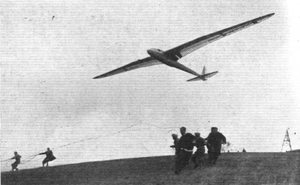DFS Fafnir
| Fafnir | |
|---|---|
 |
|
| Role | High performance glider |
| National origin | Germany |
| Manufacturer | Rhön-Rossitten Gesellschaft (RRG) |
| Designer | Alexander Lippisch |
| First flight | July–August 1930 |
| Number built | 1 |
| Developed into | RRG Fafnir 2 |
The RRG Fafnir, named after the legendary dragon, was a single seat German high performance glider designed by Alexander Lippisch. It won the Rhön competition in 1931 and made several outstanding flights as well as setting a fashion for gull wings.
Lippisch began the design of the influential Fafnir in 1929. Its refined design proved difficult to construct and the aircraft was only just ready for flight tests at the start of the 1930 Rhön competition on the Wasserkuppe.
The Fafnir was not the first glider with a cantilever wing, for the Darmstadt Konsul had been built seven years earlier but a cantilever wing with an aspect ratio of almost 20 was exceptional. The single wing spar had to be deep for strength and Lippisch accommodated this by using the Göttingen 652 airfoil which is thick and strongly cambered, additionally providing lift at low speeds. The wing root was faired into the upper fuselage. The wing was straight tapered in plan to elliptical tips and the profile changed along the span through the less cambered, more widely used Göttingen 535 to the familiar Clarke Y profile with washout at the tips to prevent tip stalling. It was plywood covered ahead of the spar, with fabric covering aft. Laterally stabilising dihedral was not common on gliders in 1929 but Lippisch applied it to about 40% of the inner span on the Fafnir, producing a gull wing. Many later gliders followed this form, though it is harder to build and has no solid aerodynamic justification. The trailing edges of the outer part of the wing carried broad and constant chord ailerons.
...
Wikipedia
